Like-Minded Scientists Gather at World's Largest Earth and Space Meeting
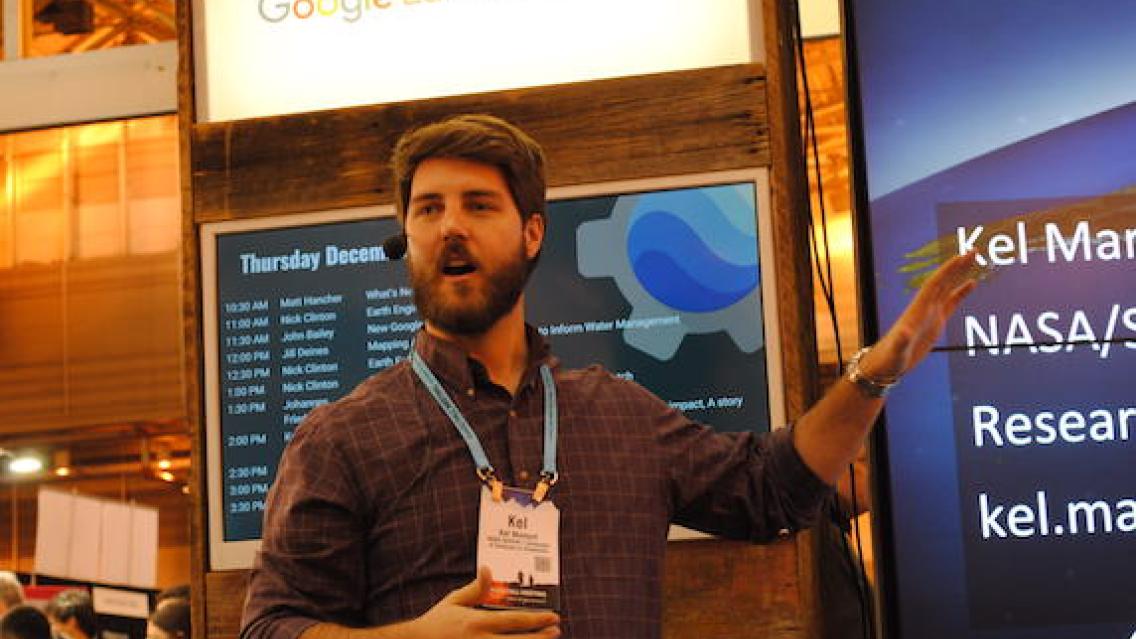
SERVIR Global representatives from Africa, Hindu Kush-Himalaya, Lower Mekong region, NASA Science Coordination Office (SCO), USAID, and the SERVIR Applied Sciences Teams (AST) attended the American Geophysical Union’s (AGU) 50th Fall Conference in New Orleans, Louisiana, 11-15 December 2017.
Attracting over 20,000 Earth and space scientists, educators, students, and other leaders, the conference is the largest Earth and space meeting in the world. During the week, SERVIR Global representatives met with subject matter experts and thought leaders to discuss emerging trends and the latest research in geospatial technologies, as well as participated in oral and poster presentations.
SERVIR Chief Scientist, Ashutosh Limaye, noted, “AGU enables scientists across the SERVIR network to convene and present in a preeminent annual science gathering that spurs ideas for new services and enhancements for existing services based on the latest science.”
Oral Sessions
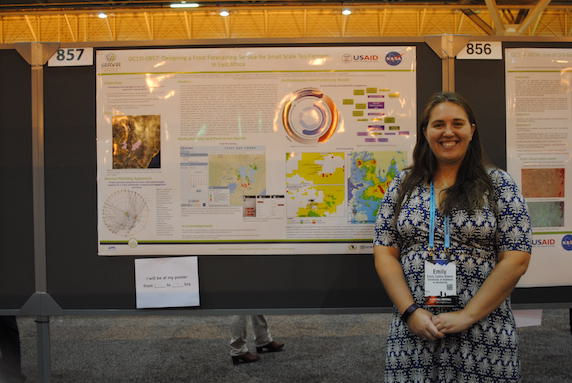 |
| SERVIR SCO’s Emily Adams at the AGU's 50th Fall Conference, presenting a poster on frost monitoring and forecasting in East Africa |
Presenting SERVIR’s most recent research in West Africa, SCO’s Africa Flores and Emil Cherrington led an oral session on “Use of Earth Observations in Mitigating Major Environmental Challenges in Africa.” The region faces major challenges in food security and agriculture, water resources, disaster risk reduction, and rapidly changing land use and ecosystems. Attended by scientists, the session featured how SERVIR’s research efforts have incorporated satellite technologies to develop new tools, products, and services to support environmental decision making by government agencies, non-government organizations, and the public.
Flores highlighted, “It’s a great venue for SERVIR to showcase the science we’re doing in other regions of the world and make connections with scientists that may benefit from what we’re doing and vice versa.”
Outcomes of the session included awareness of weather station networks across Africa, which can provide critical weather data for SERVIR’s products and tools. SERVIR also learned of innovative land cover efforts in West Africa that may complement current SERVIR land cover mapping efforts in the region.
In another oral session, SERVIR–Hindu Kush Himalaya presented on the latest advances in Earth observation for mitigating major environmental challenges in South and Southeast Asia. Similarly, SERVIR-Mekong led their own session that showcased a case study on their implemented early flood warning system in Lower Mekong countries, such as Myanmar and Cambodia.
Poster Sessions
Occurring throughout the five-day conference, poster sessions provided attendees the opportunity to have more in-depth, one-to-one conversations with other scientists and exchange ideas. SERVIR’s SCO had a notable presence during the Africa and South and Southeast Asia poster sessions. Presenting her poster on frost monitoring and forecasting for tea farmers in East Africa, for instance, SCO Emily Adams noted, “AGU is almost like a big family reunion. And the poster sessions give you the chance to interact with all sorts of new people; their different perspectives allow me to consider other approaches as I move forward with projects in the region.”
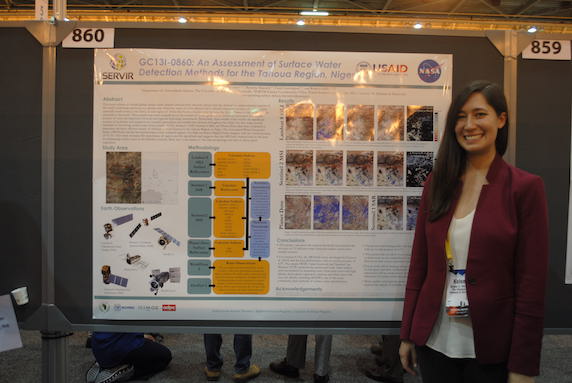 |
| SERVIR SCO Graduate Research Assistant Kelsey Herndon presents her poster, ‘An Assessment of Surface Water Detection Algorithms for the Tahoua Region, Niger’ |
Later in the conference, for example, Adams met Liza Goldberg, a 16-year-old high school student interning at NASA’s Goddard Space Flight Center, who presented her research on a global wetland monitoring system. Seeing its applicability in better managing and protecting wetland resources, Adams plans to have further discussions with Goldberg about possibly collaborating with SERVIR-Eastern and Southern Africa in adopting the tool.
During the South and Southeast Asia poster session, SERVIR-Hindu Kush Himalaya and SERVIR-Mekong representatives presented posters on how their research efforts on droughts and floods have led to developing tools, products, and services to support environmental decision making by governmental institutions, non-governmental agencies, and the general public. These regional challenges affect food security and agriculture, water resources, and changing land use and ecosystems.
SCO Graduate Research Assistants Kelsey Herndon and Thai Munroe also presented their posters on “Surface Water Dynamics in Niger” and “The Impact of Dams on Streamflow and Sediment Retention in the Mekong River Basin,” respectively. Of her first AGU conference, Herndon related, “It was interesting to see how one problem [surface water dynamics] was approached from different perspectives.” Similarly, Munroe noted how she benefited from speaking with other subject matter experts in the field for suggestions on her research.
NASA’s Hyperwall and Google Booth
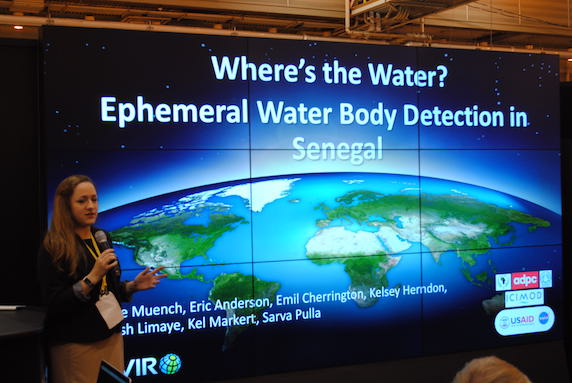 |
| Rebekke Muench at the NASA Hyperwall Booth, highlighting SERVIR-West Africa |
NASA’s Hyperwall – a nine screen video wall – aided in illustrating the many accomplishments of international development collaboration in Earth observation data and scientific research via high definition images and data visualization. In delivering a talk on water body monitoring in Senegal, Rebekke Muench noted, “The opportunity to present at the NASA booth allowed for a unique venue amongst the many AGU posters and presentations to share some of the exciting new tools and science that SERVIR is currently working on.”
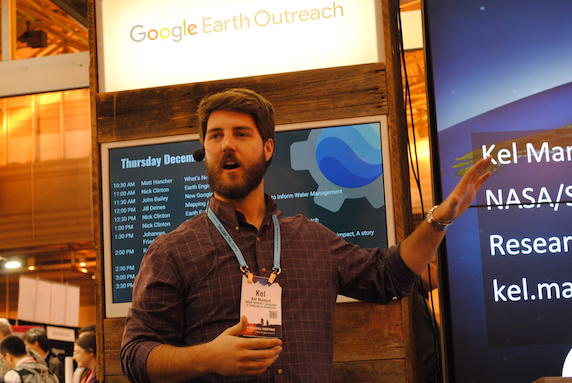 |
| SERVIR SCO’s Kel Markert gives a presentation at the Google Booth |
As a follow up to Muench’s presentation in the same exhibit hall, SCO Kel Markert and Co-science Data Lead David Saah of SERVIR-Mekong gave a presentation at the Google Booth on “SERVIR’s Approach to Leveraging Earth Engine for Development Impact.” Markert showcased how the combination of SERVIR’s services and use of Google Earth Engine allows for a more affordable and efficient means of providing data access and surface water detection methods, while circumventing technical challenges, such as low Internet bandwidth, in West Africa.
In other meetings, the SERVIR SCO team met talented young scientists doing a wide range of novel research. One graduate student, in particular, developed an algorithm that leverages Google Earth Engine and data from both Landsat satellites for creating land use maps and automatically updating them. With her novel, cost-effective approach (only requiring a couple of days, instead of years, to generate maps) the SERVIR SCO team immediately recognized the potential benefits of applying her method for ongoing projects in West Africa.
Building upon SERVIR’s continuing partnership with Google, both teams discussed opportunities for Google to provide additional computational resources to SERVIR-West Africa, which is currently exploring how to use cloud computing for environmental monitoring in the region’s 13 countries.
The AGU conference served as a great opportunity for the SERVIR Global network to form new partnerships and further strengthen existing relationships. Since its first participation in the event three years ago, the fruitful outcomes of this year’s conference illustrated the value of SERVIR continuing its participation in the largest Earth and space science meeting in the world.

